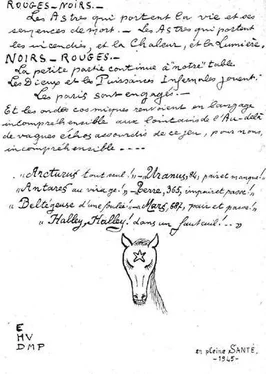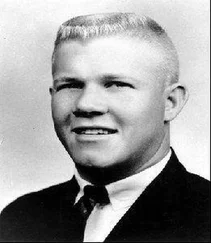Why had Madame Khaït gone to Petiot anyway? Was it to report her decision not to participate in his fraudulent scheme? Was it to pick up the money to pay the attorney, as he had earlier promised, or was there yet some other, unknown reason?
Madame Khaït’s husband, David, uncertain how to proceed, listened to the pleas in the letters and refrained from approaching the police, which was only done by Fernand on May 7, 1942. David Khaït, being Jewish, had good reasons for avoiding contact with authorities and had first gone to Petiot, who claimed not to have seen his wife on the day she disappeared. He had not seen her, he added, since the day he visited her house after Raymonde’s arrest. “All that I know,” Petiot told him in his office, “is that she wanted to leave for the Free Zone.”
Petiot did say that he had earlier given her a contact in the unoccupied zone, should she want to flee. While David Khaït waited, Petiot grabbed a postcard, addressed it to “Monsieur Gaston,” Plagne, near Loupiac, Cantal, in southwest France, and scribbled the single line: “Have you seen the party I sent to you?” Petiot placed a stamp on the card and gave it to Khaït.
The following month, when David Khaït visited Petiot a second time, the doctor said he had not heard from his contact. On a third encounter, in Olmi’s office at the Palace of Justice in early May, Petiot said that he had just learned that his associate in the unoccupied zone had not seen Madame Khaït.
“You wretch! You criminal!” Khaït shouted. “It’s you who killed my wife!” He could read it in the physician’s eyes, he said. Petiot replied calmly that the man was crazy and needed to be locked up.
When questioned by the police, Petiot said he had no idea what happened to Marthe Khaït and denied that he had given her any injections. He also alleged that he had received a letter from Madame Khaït’s daughter, threatening to blackmail him if he did not say that the original prescriptions were genuine. The story of his injections, Petiot said, was simply the lie of a drug addict desperate to save her own skin.
Baudet was found guilty on July 15, 1942. Petiot was also fined and sentenced for drug trafficking, though his attorney, René Floriot, succeeded in January 1943 in having the fines of the Van Bever and Khaït cases combined for a total of 2,400 francs. Despite the verdict, many who worked on the case remained suspicious. Maître Véron, for one, urged Magistrate Olmi to charge Petiot with kidnapping or murder. He would later come to play an important role in the suspect’s life.
The police continued to look for Madame Khaït, under that name as well as several possible aliases suggested by her family, including her maiden name, Fortin, and variations of her earlier name by marriage, Lavie, such as Lavic, Laric, and Lepic. They never found her. So just three days after Van Bever vanished, another witness in a separate case against Dr. Petiot had disappeared.
The police eventually searched Petiot’s apartment on rue Caumartin, finding nothing whatsoever to implicate him in the disappearance of either person. They did, however, find a surprising number of jewels, linen, and other objects of value in an office drawer, which Petiot explained as “gifts of clients” who could not afford his fees. Almost apologetically, as the search failed to turn up any evidence of the missing persons, the presiding officer, Achille Olmi, turned to Petiot and said, “Rest assured, no one is accusing you of burning them in your stove.”
5.
“100,000 AUTOPSIES”
MY DEAR COMMISSAIRE, I DO NOT ENVY YOU INVESTIGATORS WHEN IT COMES TO PUTTING NAMES ON THIS DEBRIS.
—DR. Albert Paul
PARIS’S newspapers devoured the story of the monster in the elegant 16th arrondissement. Marcel Petiot was dubbed “The New Landru,” after the infamous French murderer who had been convicted in 1921 for killing eleven people, ten of them lovers. Le Petit Parisien chose that sobriquet for its two-inch-high headlines on Monday, March 13. L’Oeuvre used it that morning as well, reporting that some twenty-five or perhaps thirty women had been killed or “burned alive” in the charnel house. L’Oeuvre and its many rivals in the capital competed in depicting the killer as a sadistic sex fiend who tortured women before he watched their “throes of agony” in his viewer and then mutilated their bodies.
Le Matin was also emphasizing the “demonic, erotic” nature of the crimes. All the bodies found at rue Le Sueur—that is, those that were not chopped up, burned, or caked with lime—were naked. When exactly had the killer removed the victim’s clothes? Was it before or after he latched them to the hooks of his padded cell? To complete the nightmare image, Le Matin was also reporting that Dr. Petiot would wear a frightening mask as he tortured and finished off his victims.
As the controlled French press covered the Petiot case for the home market, the official state-run German news agency DNB, Deutsches Nachrichtenbüro, broadcast the news internationally of the “charred and dismembered skeletons of 25 women” found on the physician’s property. Almost every night, its bulletins detailed how Petiot pedaled to the empty house near the Arc de Triomphe to conduct the grim business that filled his lime pit and produced the nauseating smoke that emanated from his chimney.
The DNB, like the Parisian press, sometimes reported that Georgette Petiot knew or participated in her husband’s activities; other times, she was presented as oblivious to his double life. Usually, however, the German-controlled press emphasized that Petiot preyed on women. The physician was described as leaving his wife at home as he arranged nightly rendezvous on rue Le Sueur. Neighbors looked away, disinclined to interfere with the physician’s presumably romantic liaisons.
The female visitors to his property—often assumed to be “shady ladies of the demi-monde”—sought packets of heroin, cocaine, or some other narcotic. What they received, however, was not “the white powders of forgetfulness, but death itself.” Petiot, with his hypodermic needle, was quickly deduced to have injected a poison into the veins of his victims. Whether it was a yet-to-be-identified substance, an overdose of some generic drug, or perhaps a concoction of his own invention was not clear.
Thanks to his connections, a German journalist for the DNB, Karl Schmidt, received one of the first tours of the triangular room. The butcher, he speculated, drugged his victim and then dragged her into the dark room, where she was tied up and suspended from the hooks on the back wall. The murderer projected two spotlights onto her face, watching the “human agony until the last convulsion.” The physician, using his medical skills, proceeded to inflict torture, presumably prolonging the pain as long as possible. He then dissected “the twisted corpse” and tossed it into the lime pit.
Massu, however, was far from ready to draw any conclusion. Known for his caution, the commissaire preferred to move slowly, building his case piece by piece and proceeding with as much certainty as possible, rather than rushing into a mistake. He was skeptical, particularly of evidence that seemed too clear or obvious. “You have often heard me say,” Massu said to Brigade Secretary Canitrot, “it is necessary to be suspicious of the so-called evidence.” When policemen make hasty conclusions based on “the evidence,” Massu believed, they often fall into a river of error, with potentially “catastrophic” results. The fundamental problem for a detective was how to interpret the evidence.
On one hand, Massu was relieved to receive unambiguous instructions from the Gestapo, hoping of course that it would mean that German authorities would not interfere with or obstruct his investigation. At the same time, there was another concern. The Gestapo rarely expressed immediate interest in a French criminal case. When they did, particularly when ordering an arrest, it was usually to catch a culprit whose crime consisted of little more than opposing the Nazi regime. Did this mean that the owner of the house at No. 21 rue Le Sueur possibly served the French Resistance?
Читать дальше












